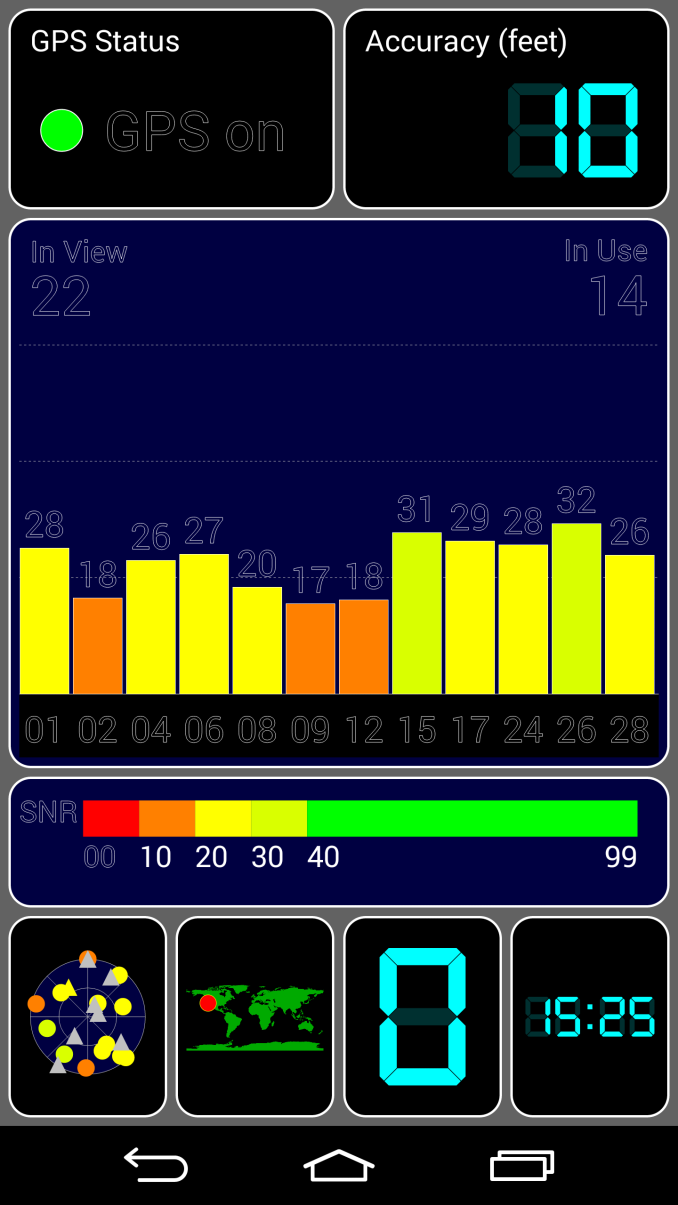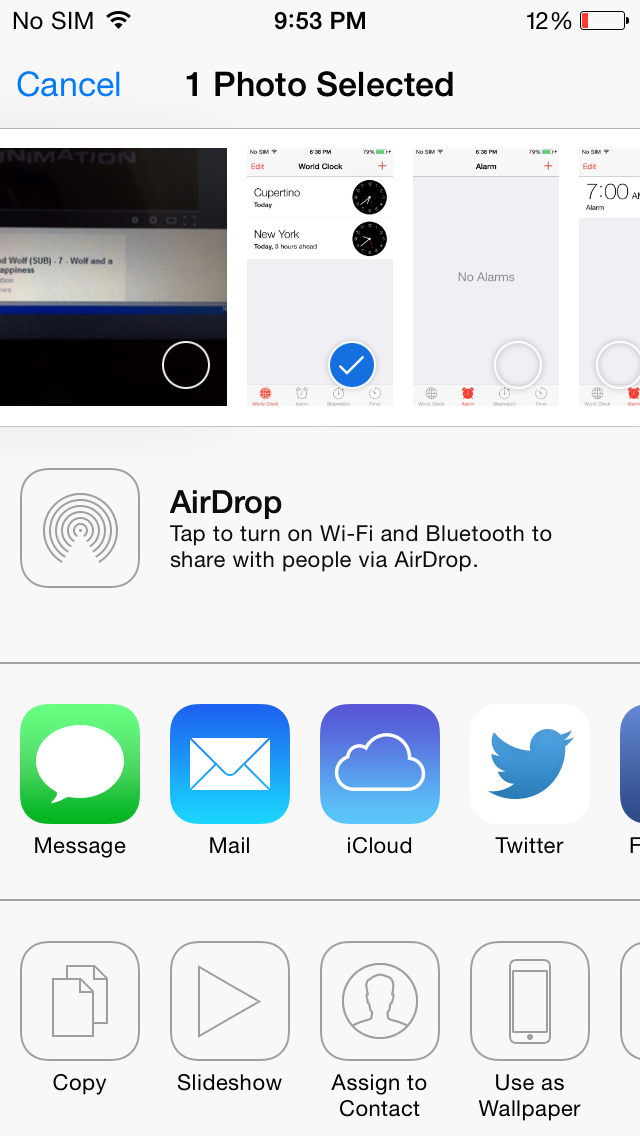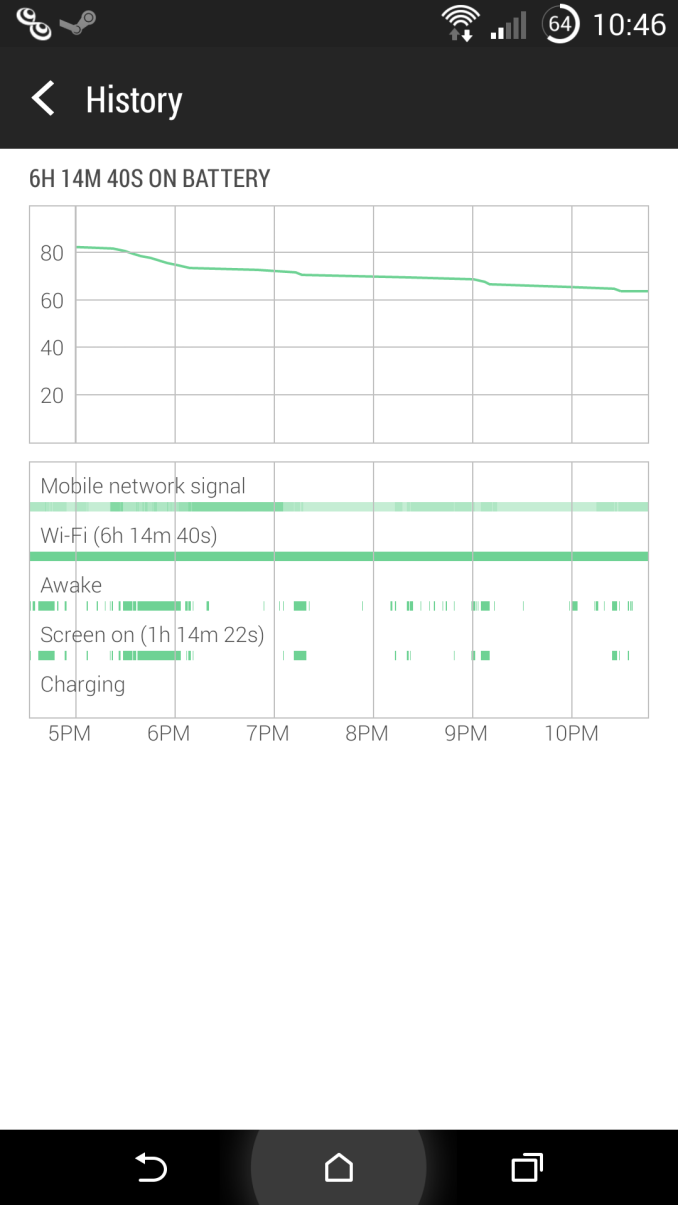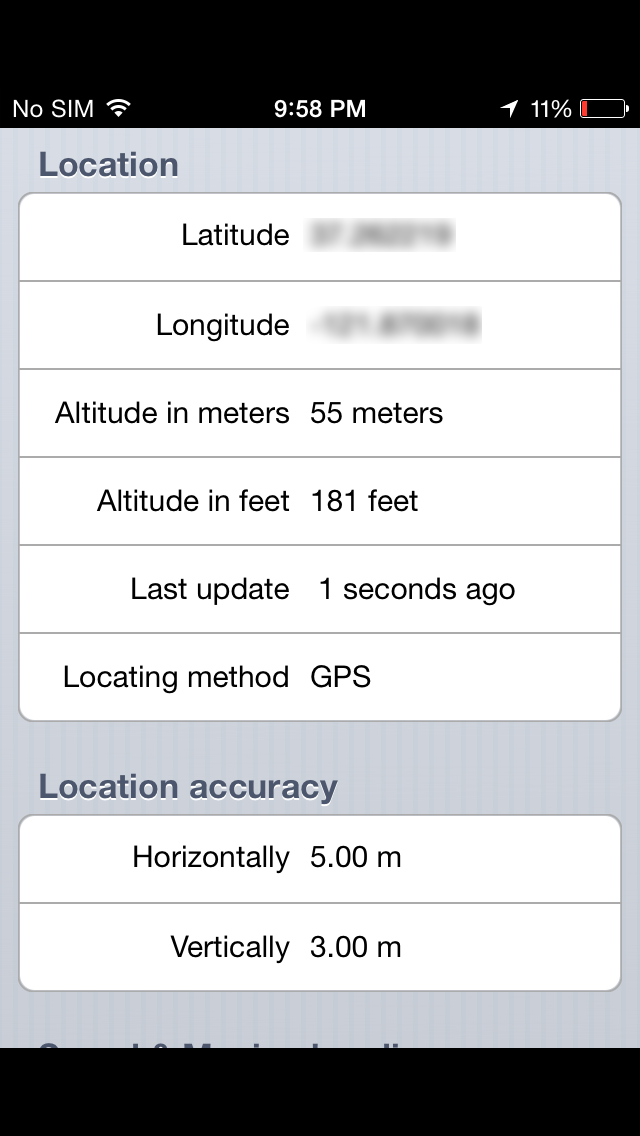A Month with the iPhone 5s: Impressions from an Android User
by Joshua Ho on August 24, 2014 7:00 AM ESTSoftware
From a purely functional perspective, there are some pain points involved in moving from Android 4.4 to iOS 7. While it’s been talked to death now, the lack of a system similar to intents on Android and the lack of customizable keyboards are definitely a bit on the frustrating side. For example, while on Android manually uploading screenshots, photos, and video to Dropbox is a relatively painless process, doing the same on iOS isn’t possible. While one of the first things I do on any Android smartphone is install SwiftKey, it’s not possible to do the same on iOS. This immediately causes my typing speed to drop, although in the case of iOS’ keyboard this is mostly due to the lack of punctuation in the letter page. However, these two immediate issues are about to be irrelevant with the release of iOS 8, so this is more of a temporary issue than a permanent one.
Although also temporary, for those that have become accustomed to the significant amount of custom control provided by camera apps from HTC and Samsung, the iOS camera application is comparatively barren. There's the ability to toggle HDR, flash, tap to focus/expose and lock focus/exposure. In effect, there's no real way to set manual controls. While the auto mode is pretty much as good as it gets, I find myself missing manual controls when it comes to taking macro photos and in other similarly extreme conditions.
There are a few other issues though. To someone that has almost solely used Android smartphones, the notification drawer has some odd behavior. It’s never really made sense to me why notifications can only be cleared by application. I definitely think a clear all notifications button would be a good addition for the future, but this is only a significant problem if a large number of notifications build up without getting cleared away. I'm also not sure what the value is to segregating "all" and "missed" notifications. Android definitely handles this better, although it probably makes more sense to those that have used iOS' notification system from the start.
Outside of these issues, there’s quite a lot to like. The vast majority of applications that I used had a consistent style that fit with iOS 7, with no strange scaling issues or unexpected behavior. This still tends to be a problem in Android, so it’s refreshing to have an app ecosystem that tends to keep up with the design guidelines set with each new iOS release. There’s also just about no stuttering or pausing in the experience. While Android L and ART should bring much better performance to Android smartphones, in iOS it seems that such performance issues haven’t really existed in the first place.
iOS and Android/Sense 6 battery stats
Of course, while there are some issues that could be fixed, there are others that are much more fundamental. One of these is direct access to the file system. While it’s quite convenient in Android to trawl through system files to learn about the underlying hardware and move around data using a file explorer, it makes sense to completely sandbox applications from each other to improve security. Another advantage of sandboxing applications is that orphan files are nonexistent, which is an issue on Android devices.
In addition to file system differences, it’s a bit frustrating to not have detailed battery life statistics when it comes to how much CPU time each application consumes, how long application wakes up the system while the screen is off, and similar details. However, it once again makes sense for Apple to do this. After all, iOS battery management is already quite stringent. In general, applications are strictly regulated and most cannot run in the background for any significant amount of time. On Android, it's possible for a single rogue application to ruin battery life, but this same system means that multitasking tends to be much faster and smoother.
If anything, this may be the real difference that matters when comparing iOS and Android. While Android and iOS are largely similar in features, there is a fundamental divide in the way the two OSes are designed. At its core, iOS is designed with average users in mind. As a result, there’s a strong emphasis on making things “just work” and hiding information that would simply confuse and frustrate people that don’t care about the underlying hardware and software. Android at its core is targeted at those that want to have the full PC experience on their phone, and as a result there’s much more information and low level functionality for those that want it. However, this can easily be frustrating and confusing for the end user. Of course, it’s fully possible for iOS to adopt features that would be targeted at advanced users, and Android can be changed to be more user friendly. If anything, this hypothetical has been the case for the past few years. Over time, Android has become a more friendly OS with the removal of the search and menu keys, going from the dark themes of 2.3 and 3.0 to the brighter, cleaner designs of today. Things like Google Maps have become considerably more simplistic, and even microSD slots had significant restrictions added to them in an attempt to simplify the user experience. Similarly, the fact that manual camera controls are even possible speaks to how Apple is adding more niche features.

GPS Info! on iOS and GPS Test on Android
However, the differences remain, and understanding this is as simple as looking at how equivalent features are implemented. For example, location services in iOS are binary in nature, and can only be turned on and off globally or for each application. In Android there’s noticeably more nuance. Location can be done only by on-device GPS, or by using WiFi/cell tower location, or by using both. In addition, it’s possible to view GPS data such as per-satellite SNR and number of satellites used and in view.
Final Words
At the end of the day, the iPhone 5s has aged quite well. While the hardware quality is a cut above, it’s more than just a matter of pure hardware. It’s clear to me that the user experience wouldn’t be nearly as good without Apple’s strong control over software. TouchID is quite possibly the best example of this, as there’s no need to wait for an official API to support fingerprint authentication for App Store purchases or other similar situations. While I felt a bit constrained by the limits in the operating system, the integration and overall quality of the experience outweighed these disadvantages. I’m not quite sure if either is better at this point, as while I definitely enjoy the amount of low-level information and customization available on Android, iOS has a much more polished and highly integrated experience.
However, in the long run it seems likely that they will converge towards largely similar feature sets. This doesn't mean that they'll be identical, as there's a distinct parallel in the Mac vs Windows debate. In Windows, adoption of new hardware features into the OS tended to be slower and not as well integrated as the OS vendor and multiple OEMs had to try and coordinate such a task. However, a major advantage of such a system was that backwards compatibity and flexibility was greater, even if it was more complicated for the end user. Similarly, Mac has tended to have new features at a faster pace and with better integration, such as high DPI displays. However, the result tends towards less control over low-level settings and less visibility into low-level information. The tight integration between hardware and software also means that it's harder to provide extensive backwards compatibility.
Of course, these are mostly broad strokes. It's not really possible to predict what the future holds, but even now we can see major differences. Google has allowed for custom OEM UIs on top of Android, and doesn't profit directly from the sale of Android OS. Similarly, the nature of smartphones dictates tight integration, so it's not really possible to upgrade the OS without a new BSP and major work on the part of the OEM to push an OTA. Apple has also managed to ensure that the app ecosystem of iOS is equal to or greater than any other mobile OS, something that was a major stumbling block with Mac OS in the early days of personal computing. While a great deal of maturation has occured in the smartphone market, there is still a long road ahead before the story can end.



_575px.PNG)
_575px.PNG)
_575px.PNG)










197 Comments
View All Comments
joelypolly - Sunday, August 24, 2014 - link
Really depends on if Apps is your main thing or not. Android simply doesn't have enough well built tablet appsjoeljfischer - Sunday, August 24, 2014 - link
I just want to note, that several more of your software issues are "resolved" in iOS 8. Specifically, Apple exposes additional camera control to 3rd party apps who wish to use them (but don't use anything but exposure in their own app), battery stats per application are exposed, and the "all" and "missed" are just "notifications" now.V-600 - Sunday, August 24, 2014 - link
IOS is something I'm looking forward to seeing. It borrows a lot of good ideas and extends a few more past android (from the look of things so far). There will undoubtedly be cries of copying but....meh...there always are, and it will give android something new to aim towards next time....when there will again be cries of copying.AceMcLoud - Sunday, August 24, 2014 - link
"cries of copying"Many of the features Apple is allegedly "copying" have been in Mac OS for years if not decades ;-)
Ratman6161 - Sunday, August 24, 2014 - link
The "issues" go a lot deeper than adding a few camera features. It's the overall attitude towards users: "This is our phone, take it or leave it". With an android device, if you don't like the keyboard the OEM provided - use a different one. Launchers, cameras, you name it - use the one you like or even mix and match.Example: Last Thursday my Samsung Galaxy Tab S 8.4 came in at work. Of course it came with TouchWiz...which lasted about two hours only because I wanted to give it a shot before trashing it. After than it was over to Apex Launcher. I liked Samsung's keyboard though so I kept that. I have my own Exchange Client for work email and a different third party app I like for personal mail.
Basically through the easy customization I'm never stuck with what the OEM decided to provide. Moreover, I'm able to make my Droid Maxx Phone, Asus personal tablet and Samsung work tablet all look and feel much the same - and that's all without any need to root, unlock ect. I can easily switch between the three and they all work the same.
All that said, and Android user really doesn't have to do any customization if they don't want to. My wife uses her Droid Mini pretty much as it came out of the box other than putting a couple of widgets on her screen. She really doesn't need to know and doesn't want to know any more than that and it works great for her.
Ratman6161 - Sunday, August 24, 2014 - link
One other thing. For the reasons mentioned above, when shopping for an Android device I can buy without worrying too much about what software does or doesn't come with it and regardless of weather or not I like the software choices the OEM made. With Apple, if you like it as is, you are golden. But If there is anything you don't like about it you are often stuck with it.bernstein - Sunday, August 24, 2014 - link
> With Apple, if you like it as is, you are golden. But If there is anything you don't like about it you are stuck with it.So true. While today that is mostly limited to how the OS works (any app except clock/phone/texts/browser is replaceable) it pains me. Yet for all of androids customizability & diversity i could not find a launcher that works the way i want & has the polish i expect... be it apex, action, nova, miui, touchwiz, sony, google, aokp, cyanogen... they all have cool things yet none is well balanced.
Teknobug - Sunday, August 24, 2014 - link
Since I already have an iPad, I see no reason to getting an iPhone, at times they're slightly less convenient than an Android phone. I'll be sticking to my Moto X for a while, but i have pondered the thought of upgrading to an iPhone 5S someday but rumors is Apple is releasing yet another phone this September.Drazick - Sunday, August 24, 2014 - link
On the contrary, Windows always supported newer hardware and technologies (High DPI in some ways was there in the XP days).Look at the support for SSD (Trim), OpenCL, etc...
You are right that usually Windows' first implementation is rough around the edges while OS X's bring support only when the technology is mature enough and polished.
Ratman6161 - Monday, August 25, 2014 - link
Yes, slow adoption of certain technologies is usually not the fault of Microsoft/Windows. A good example is Thuderbolt - which for all the hype is actually an Intel technology, not Apple (which this crowd I'm sure already knows). Its the fact that computer OEM's and motherboard makers have been slow to offer PC motherboards with the technology that's the issue.Another example is USB 3.0 where it was Intel standing in the way. For example my Z68 based Motherboard for my i72600K has a third party USB 3.0 controller because Intel did not include support for it in the Z68 Chipset. Windows of course had no problem with it - it just needs a driver from the third party chip maker.
Of course that's the issue with the Windows platform as a whole: A lot of things from multiple companies have to come together to make the technology available where as if Apple wants to implement a new tech, they can just do it. Its the price we pay for diversity, choice, and competition.